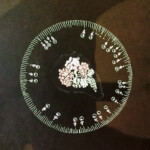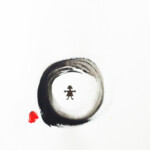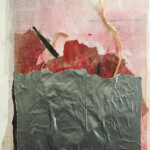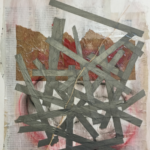Dear Readers,
I recently sat down with Sonya V. Thursby who is one of the facilitators at Sheena’s Place (SP). I was curious about what brought her to work in this community. It was lovely to learn more about her and what she does both inside and outside of SP. Sonya co-facilitates A Closer Look at Trauma and ED group, with Lia Falzon. In the past she has facilitated a number of expressive art groups such as open art studio and altering books. She is facilitating 8-in-8 over this summer where participants look at different artists and explore their technique and then take that as inspiration. The intention of that group is to “stretch their muscles of expression in a playful way”. She described it as an experimental, playful, and fun group. In all the groups she runs at SP, she uses her art therapy training and supports members in exploring what may arise for them through their artwork or through the group itself.
I asked how Sonya found her way to SP. She explained that when she was writing up her thesis research she was approached by an SP facilitator who was looking for another art therapist that had a similar approach. She found that she really liked the approach and was curious about what SP was. Sonya described it as “a double opportunity to learn how to support people with Eating Disorders as well as to learn from another art therapist and facilitator. “When I started working with the population I fell in love. I found myself seeing folks working really hard toward recovery in different ways and maybe struggling sometimes. And I felt a lot of compassion. That was evoked in the beginning. I became curious about how we could use the expressive arts to support people remembering all the other parts of themselves that get lost under the symptoms and the behaviours”.
When I asked what she gets out of her groups, Sonya explained how passionate she is about all of the groups she has co-facilitated with Debbie Anderson and Lia Falzon and facilitated on her own. The A Closer Look at ED and Trauma group is a current favourite. “I really like co-facilitating with Lia. I think we bring a lot of strengths in combination. It’s really gorgeous when we are present to a member finding another piece in the puzzle of their recovery process”. Her own experience with art making throughout her life has always been a form of expression. What she has found over the last 10 years is how our hands bypass the thinking part of ourselves – “the protecting part of ourselves”. For her, using art making in terms of healing and supporting recovery and discovery is that something that happens with our hands that can show us a little bit more about what we are trying to know or understand. It is also an opportunity to be playful, she explained, “if we can park our perfectionist part of ourselves. Art making doesn’t require language. We are often trying to find understanding and make meaning and sometimes we don’t have the words yet. Art making can be an additional element of access to making meaning and understanding”.
Sonya believes that an art therapist with training in the psychodynamic and psychology of the mind, especially in terms of trauma training, brings art making skills to the table and also brings insight and training into how our humanity works. Being able to facilitate the groups or work with individuals using art making is introducing what she refers to as the third element in the psychotherapeutic process. “There’s the individual, the therapist, and then the art process and the art product. There’s the opportunity for more exploration and expression. It is an additional layer of possibility. When people make art on their own it is gorgeous and beautiful and there are so many possibilities with that. Art making in the context of support groups or clinical groups with an art therapist is an opportunity to go a little bit further. Maybe there’s a little door that gets opened by a prompt or an invitation. With art therapists, the art making can be prompted by a wide open or specific invitation, and yet what the maker can discover in their making process can be insightful with an additional possibility. When I’m working with individuals clinically, there’s the image and then the meaning making that can happen and then an additional piece that can come into play if we just sort of shift the lens slightly—somehow there can be an additional kind of layer of revealing”.
I asked Sonya about her work with folks with Binge Eating Disorder. She explained that she also works with individuals with BED because “they can’t get treatment anywhere else. We know that trauma is a big underlying factor for disordered eating and ED. To me, it’s appalling that slowly, slowly BED has been taken off the table as a valid, severe experience”. Sheena’s Place has introduced supports for BED over the last 2 years and clients have expressed gratitude and relief for these services.
What Sonya finds rewarding in her work is witnessing people noticing and locating the other parts of themselves. “That’s the gold nugget when it happens”. In her groups she hopes that clients develop an awareness of their unique and intrinsic value in the world, at Sheena’s Place, and in the group. One of the aspects she values about her work at SP is the learning exchange. “I learn from folks at Sheena’s Place every single time I facilitate a group. I learn about people. About folks in general and about people living with Eating Disorders”. Her hope is that folks take away as much as she does from the groups.
Outside of SP, Sonya works in a community practice where low-cost short-term counselling is offered in order to address one of the many barriers to accessing support. “I don’t know how people have found the grit to cobble together their own plan for recovery. I wish that there were more low-cost practitioners specifically supporting ED recovery”. Sonya has been in the process of compiling a list of GPs who have knowledge and interest in working with folks on the ED spectrum and has found that to be very difficult. She finds the process frustrating and explained that she cannot imagine what it is like for people trying to find their own supports. Sonya also has a private practice working with individuals, she teaches, provides workshops about mental health and wellness, and also navigates parenting.
Sonya’s comprehensive research has led her to make a commitment to teach, to continue learning, to do the groups at SP, and to work with individuals in her private practice. She stated that it feels meaningful for her to be able to contribute in some small way to folks getting some support in their recovery. “When I was researching to teach, I found the numbers. I found the statistics and they were horrifying. Getting the research done to be able to get the funding as part of our mental health system is abysmal. We can’t get the numbers to get the funding that’s needed and it is a viscous cycle. I’ve had lots of ideas over the years” she said “of how to address the lack of supports, and hopefully between the different associations out there, it will get figured it out”.
Working in the field of Eating Disorders wasn’t an intention for Sonya. Once she began the work, she discovered that there’s “a beautiful aspect of the work that I do that emerged from here that is a deep and rewarding part of my practice”.
It was a pleasure to speak with Sonya and to learn about her experience both at Sheena’s Place and in the broader community. If you would like to participate in an interview for the blog, please email me at Kmccarthy@sheenasplace.org.
*Art by Sonya V. Thursby





